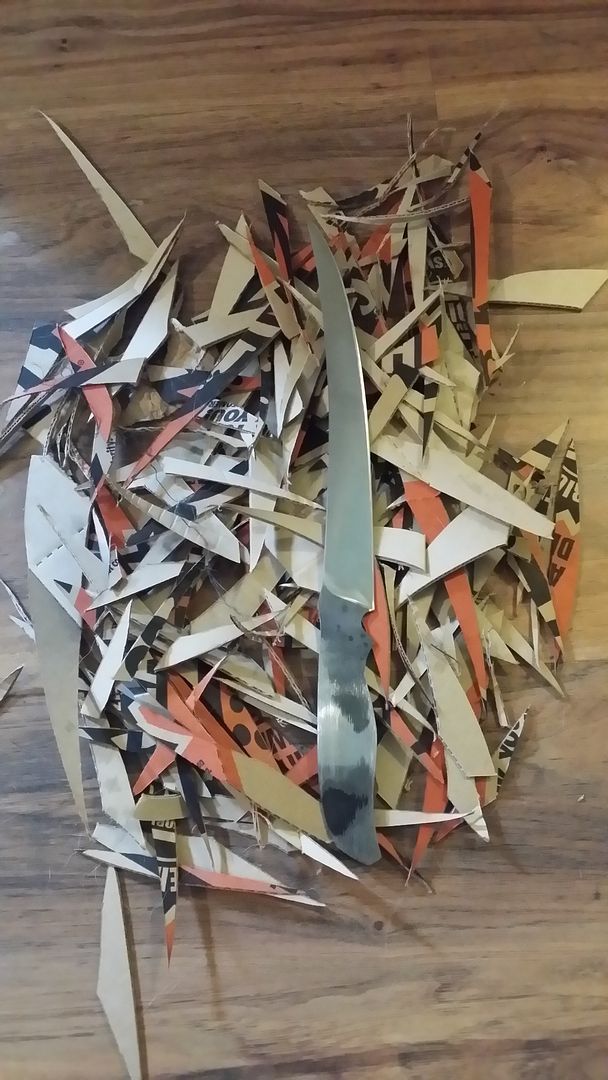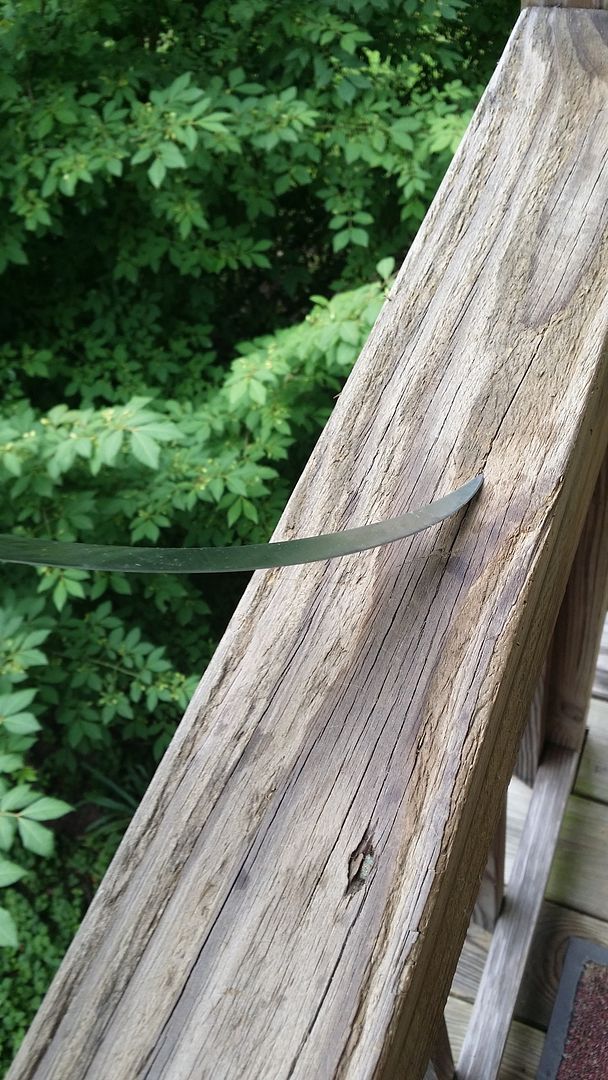The Topic of the Month for February 2017 is, Testing Edges. Many bladesmiths use a combination of chopping, plus cutting tough materials to test their edges. Some also do a flex test over a brass rod. How do you test your blade edges after heat treatment? Do you test every blade that you make?
I test each blade I make. I test for toughness, flexibility, impact resistance, tip strength and more.
I will chop on recently shed deer antlers, pine knot, coconut or whatever to see it the edge holds up.
Cutting sisal rope is one way I test edge retention and abrasion resistance.
I test in other ways and even for other things but I will let others participate now.
Chris
When it comes to testing edges, I'm a fan of the Brass Rod test. Years ago Wayne Goddard introduced me to it, and at first I was skeptical, but over time I've come to understand and rely on it to determine the correct working hardness of blades.
I also believe that there is no single test that determines whether a blade's edge is the best it can be. That being said, I also cut various things, and use the knives I produce in real world situations such as field dressing game, camp chores, and day to day carry/use. Throughout my career, I've always been the type to "try out" anything new BEFORE I decide if it's going to be sold or let out of the shop. Be that a new heat treating method, a new steel, grind, or whatever. For me it's simply a matter of necessity to prove to myself that something works, before I every make any claims, or sell a given blade. In the end, I think it all comes down to personal integrity. While it's hard to say, and hear, there are simply some makers out there who's only concern is $$$, and they will say or do anything they think will bring them that. The problem I see with that philosophy is that sooner or later is catches up with you. <img src=' http://www.americanbladesmith.com/ipboard/public/style_emoticons//smile.gi f' class='bbc_emoticon' alt=':)' />
Personally I think there are far too many knifemakers out there who simply do not test anything, but rather rely on things such as heat treating data, or Rc hardness, and make assumptions based on that data.
There was a time in my career when I was unsure of just how well my blades stacked up to other makers. It bothered me so much that I covertly purchased knives of many of the "top" makers, so that I could test them against what I was producing. What I found was astounding. Some of those blades cut well, and others, based on the makers reputation and popularity, were far inferior to what I expected, and to the blades I was producing. This caused me to ask more and more questions, and finally come to the conclusion I mentioned earlier.... many makers either don't test at all, and others, once they reach a given level of popularity, either "let off the gas" or simply rely on their popularity to sell their wares. I suppose it's up to each individual to decide how to interpret that sort of thing, but I am thankful for it, because it gave me the incentive to test EVERYTHING that leaves my shop, and even after 30 years of Bladesmithing, I destruction test at least one blade out of every 10....just to be sure that I'm where I personally think I should be.
Ed Caffrey, ABS MS
"The Montana Bladesmith"
www.CaffreyKnives.net
Thank you Ed and Chris, great information as always.
Ed, I am days away from ordering my KMG grinder as you and others here recommended. Very excited.
Ed,thanks for the very informative post. I do agree that there should be more focus on testing our products we make as bladesmiths.
What I am curious about is what tests everyone performs and what are they looking for in those tests?
I use antler and other tough mediums for testing toughness and edge geometry. I am looking for edge chipping, deflection and stability. Though I don't test each knife the same the testing is geared toward the type of knife and it's intended use. I don't expect one of my fillet knives to handle impact the same as a 10" Blade camp knife but I also don't expect the same amount of flexion from the camp knife as I do the fillet knife. I do however test each knife beyond what I would consider normal use.
I like where this discussion is going.
Chris
Here I was using a pizza box to test edge geometry and edge retention on a fillet knife. It still shaved and sliced with very little effort. This was 15N20.
I tested impact resistance and toughness on a piece of old pine knot.
I tested flexion. I did bend it beyond this also, but it's hard to get an image and test it alone.
Even after all this the tip failed. I had to get this knife back and re-grind the tip. About 1/16" broke on a big catfish.
I know a guy that is a commercial fisherman and fishing guide. He puts a knife to more fish in a week, usually over 300, than most cut in several years. He has this knife and has been field testing it for me since June. As a perk he keeps the knife in return for the feedback. As a perk to me he has taken me fishing several times.
What the failure amounted to was, I found the fail point for this steel with my heat treat at too thin of cross section.
Chris
I do similar testing, Chris. It is especially important to do extreme testing when working with a new steel. Don't trust the industry standards...too many variables involved. It's important to test to the failing point.I use African blackwood as a test medium. I figure that most people won't be hacking down a blackwood tree so the knife shouldn't see more abuse than I put it through in testing. I also test the tip by stabbing into pine and prying out chunks of wood. A tip should be able to take some abuse.
Thanks for sharing Ben. I test the tip of blades the same way on most knives. I should have tried harder to find a test for the tip of the fillet knife, as it failed in field testing.
Anyone have a recommendation on how to test the tip one really thin ground knives? I am planning to make more of them now that this one has been in field use through thousands of fish and I have requests for them.
Chris







